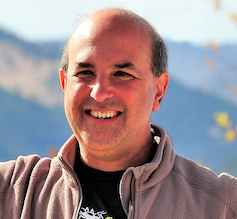I just finished teaching a few workshops introducing people to cross-country skiing, something I help with each year. In a good cross-country skiing class, the first thing you do after showing people how to put on their skis is to have them fall down. That’s of course not what we want them to learn in our workshop. Quite the contrary, by the end of the workshop we hope they will be gliding along with their bodies comfortably on top of their feet, well above the snow. But nevertheless, before having them glide, walk, stomp, pole, or anything else, we have them fall down.
The next thing we do is teach them how to get back up.
If they’re not comfortable falling and getting back up, we might even have them practice a couple times.
Ski instruction is done according to progressions. You start with some easy skills, for instance shuffling along on the skis, then learning to hold a shuffle for a little while so you glide, then adding more difficult techniques (i.e. kicking and gliding, then poling, kicking and gliding). Along the way you try to keep it fun and give lots of encouragement. If I can, I throw in some games (the kids game green-light / red-light works well for getting people to glide). If the students are smiling at the end, the class was a success, even if some students are still just shuffling along.
Although it may come under different names, the idea of progressions is important in science education as well. The concept in skiing and science is the same. You want to build on what students already know, introducing new ideas that challenge them a little but not too much. You should give lots of positive feedback along with constructive criticism. Mixing in some games is good (i.e. competition, or collaborations towards some goal, or open-ended experiments – real science is kind of a game, after all). If your students are smiling at the end, you are either a good comedian, or its a sign that you had a good class.
But in skiing, for all those other teaching techniques to work, students have to be comfortable falling down – doing things wrong, taking risks, in short, failing. Without being comfortable with failure, a student will not learn to ski well. They will never progress beyond tentative shuffling towards the efficient, poetic stride that makes skiing fun. It seems to me the same might be true of teaching real biology. For students to get beyond just memorizing facts towards coming up with their own ideas, bringing their knowledge to bear on those ideas, and testing them with experiments, the student has to be willing to put crazy half-formed ideas on the table, to have experiments not work, to have holes poked in their conclusions, and get back up and try again. And have fun with that process, rather than being traumatized by it.
When we have students fall down to start a ski class, we do it somewhere flat. We try to find somewhere with soft snow. One of us instructors does it first, often making it seem like it just happened, that even us good skiers fall. And there’s an actual technique to getting up easily which we also show. What’s the equivalent in biology teaching? I’m not totally sure. Is it getting the students to ask questions right away, even “dumb” questions, and then showing how even the dumb questions can lead to interesting answers? Is it handing them some piece of biology to explore for a bit, and showing how even their tentative, incomplete, observations are windows to deeper biological truths? Is it having them read a scientific paper that they won’t quite understand, and then helping them parse it to see that the words are more complicated than the ideas? Whatever it is, metaphorically speaking, if we want our students to learn to glide through biological ideas like a researcher, perhaps we need to start by having them fall over on a flat, soft surface where we can show them how to easily get back up.




